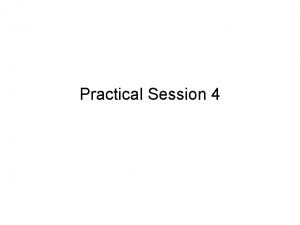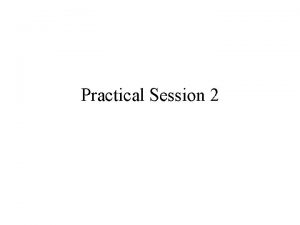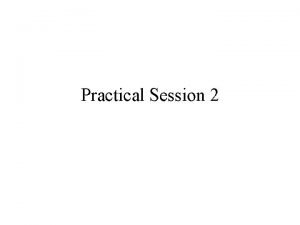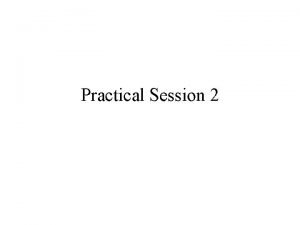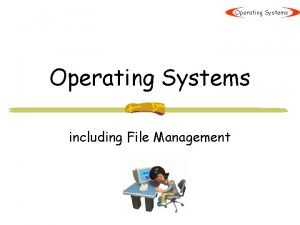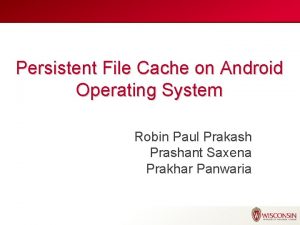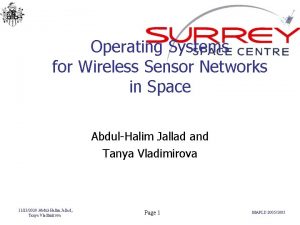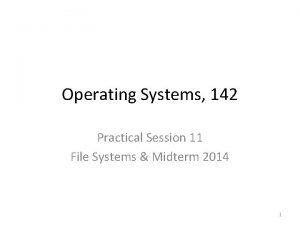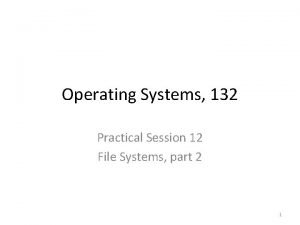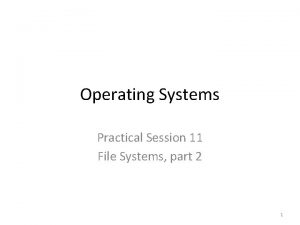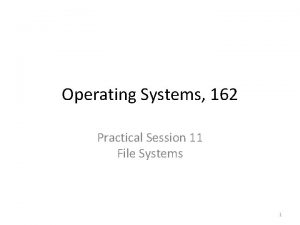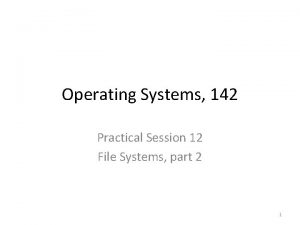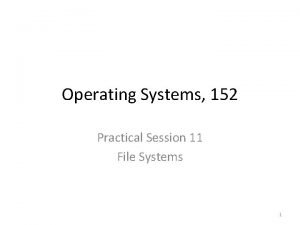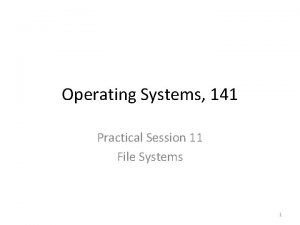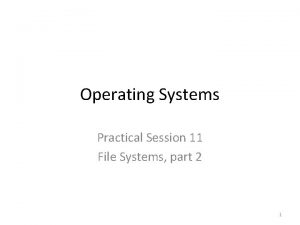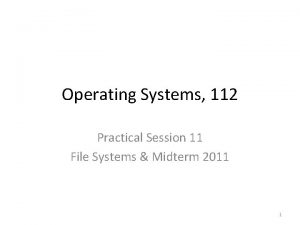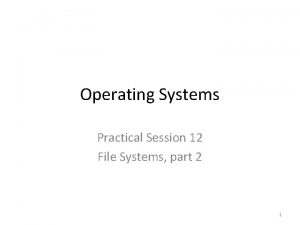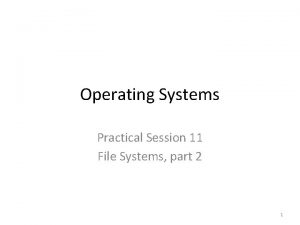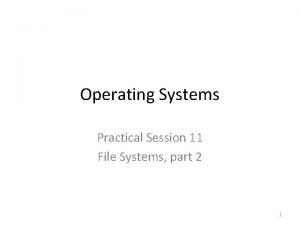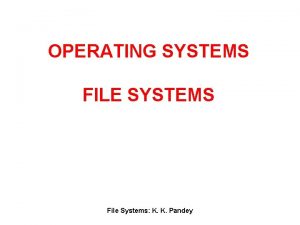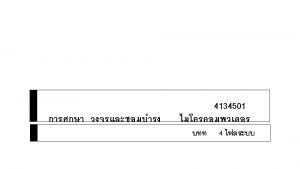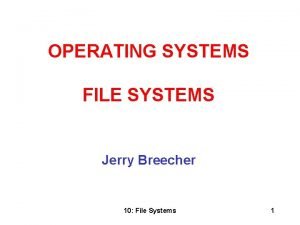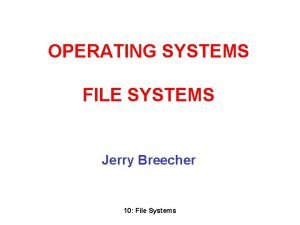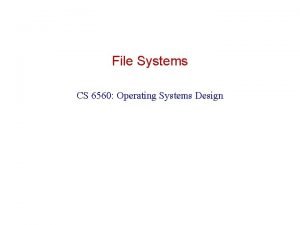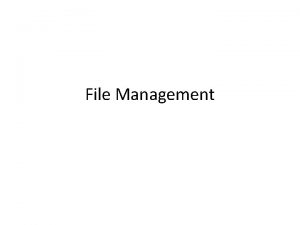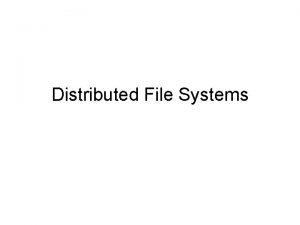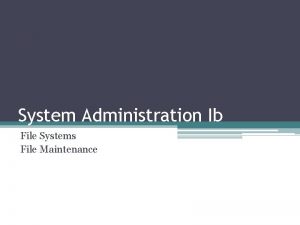Operating Systems Practical Session 11 File Systems 1



























- Slides: 27

Operating Systems Practical Session 11 File Systems 1

File Systems • Control how data is stored and retrieved • Different types: – NTFS [1, 2] (modern windows) – FAT [16, 32] (old windows and dos) – EXT [2, 3, 4] (unix) – Etc. 2

MBR – Master Boot Record • The MBR is a record located on the first sector of the disk. • It contains the information on how the logical partitions and containing file systems are organized on that disk. 3

MBR – Boot Loader • The MBR also contains the boot loader executable code. When the PC starts the BIOS load the boot loader of the selected disk into the memory and execute it. • This code may serve as a loader for the installed operating system – usually since a sector size is only 512 b and the MBR must take only 1 sector, the loader may load and pass control over to a second stage loader located elsewhere. 4

MBR – Partition Table • Finally, the MBR also contains the partition table Partitions are logical splits of the disk Each partition can contain its own file system that will manage the files stored on this partition. 5

The Ext File system – inode based • Keep records on files using a data structure called inode. – A Directory is also a file • Each inode keeps a metadata representing a single file • Common on unix like operating systems • The file-system metadata is located on a special block called the superblock and may span additional blocks 6

Ext File system layout – inode based (Tanenbaum) 7

What is an inode • An inode is a structure on the disk that represents a file, directory, symbolic link, etc. • inodes do not contain the data of the file / directory / etc. that they represent. they link to the blocks that actually contain the data. • The inodes themselves have a well-defined size which lets them be placed in easily indexed arrays. 8

Index-Nodes (i-nodes) General file attributes File Size Hard. Link count The number of hard-links to the file Usually between 10 and 12 9

Directories • Each directory is a list of directory entries. Each directory entry associates one file name with one inode number To find a file, the directory entry is searched for the associated filename. • The root directory is always stored in inode number two, so that the file system code can find it at mount time. 10

Directories • The special directories ". " (current directory) and ". . " (parent directory) are implemented by storing the names ". " and ". . " in the directory, and the inode number of the current and parent directories in the inode field. The only special treatment these two entries receive is that they are automatically created when any new directory is made, and they cannot be deleted. 11

XV 6

Layers File descriptor Pathname Directory Inode Logging (Journaling) Buffer cache Disk Process Lookup File System Cache Hardware 13

File descriptor (file. h) struct file { enum { FD_NONE, FD_PIPE, FD_INODE } type; int ref; // reference count char readable; char writable; struct pipe *pipe; struct inode *ip; uint off; }; struct { struct spinlock; struct file[NFILE]; } ftable; 14

File descriptor (file. c) // Increment ref count for file f. struct file* filedup(struct file *f) { acquire(&ftable. lock); if(f->ref < 1) panic("filedup"); f->ref++; release(&ftable. lock); return f; } // Allocate a file structure. struct file* filealloc(void) { struct file *f; acquire(&ftable. lock); for(f = ftable. file; f < ftable. file + NFILE; f++){ if(f->ref == 0){ f->ref = 1; release(&ftable. lock); return f; } } release(&ftable. lock); return 0; } 15

Inodes (file. h) and Dinode (fs. h) // in-memory copy of an inode struct inode { uint dev; // Device number uint inum; // Inode number int ref; // Reference count int flags; // I_BUSY, I_VALID short type; // copy of disk inode short major; short minor; short nlink; uint size; uint addrs[NDIRECT+1]; }; // On-disk inode structure struct dinode { // File type short type; // Major device number (T_DEV only) short major; // Minor device number (T_DEV only) short minor; // Number of links to inode in file system short nlink; // Size of file (bytes) uint size; // Data block addresses uint addrs[NDIRECT+1]; }; 16

Block map (fs. c) return/allocate block position // Inode content // // The content (data) associated with each inode is stored // in blocks on the disk. The first NDIRECT block numbers // are listed in ip->addrs[]. The next NINDIRECT blocks are // listed in block ip->addrs[NDIRECT]. bn -= NDIRECT; if(bn < NINDIRECT){ // Load indirect block, allocating if necessary. if((addr = ip->addrs[NDIRECT]) == 0) ip->addrs[NDIRECT] = addr = balloc(ip->dev); bp = bread(ip->dev, addr); a = (uint*)bp->data; if((addr = a[bn]) == 0){ a[bn] = addr = balloc(ip->dev); log_write(bp); } brelse(bp); return addr; } // Return the disk block address of the nth block in inode ip. // If there is no such block, bmap allocates one. static uint bmap(struct inode *ip, uint bn) { uint addr, *a; struct buf *bp; if(bn < NDIRECT){ if((addr = ip->addrs[bn]) == 0) ip->addrs[bn] = addr = balloc(ip->dev); return addr; } panic("bmap: out of range"); } 17

Buffer cache (buf. h) struct buf { int flags; uint dev; uint sector; struct buf *prev; // LRU cache list struct buf *next; struct buf *qnext; // disk queue uchar data[512]; }; struct { struct spinlock; struct buf[NBUF]; // Linked list of all buffers, through prev/next. // head. next is most recently used. struct buf head; } bcache; #define B_BUSY 0 x 1 // buffer is locked by some process #define B_VALID 0 x 2 // buffer has been read from disk #define B_DIRTY 0 x 4 // buffer needs to be written to disk 18

Buffer cache (bio. c) struct buf* bread(uint dev, uint sector) { struct buf *b; b = bget(dev, sector); if(!(b->flags & B_VALID)) iderw(b); return b; } void bwrite(struct buf *b) { if((b->flags & B_BUSY) == 0) panic("bwrite"); b->flags |= B_DIRTY; iderw(b); } Synchronize the cached block with the block on disk using IDE driver 19

Disk (ide. c) void iderw(struct buf *b) { struct buf **pp; void ideintr(void) { struct buf *b; // First queued buffer is the active request. acquire(&idelock); if((b = idequeue) == 0){ release(&idelock); // cprintf("spurious IDE interruptn"); return; } idequeue = b->qnext; if(!(b->flags & B_BUSY)) panic("iderw: buf not busy"); if((b->flags & (B_VALID|B_DIRTY)) == B_VALID) panic("iderw: nothing to do"); if(b->dev != 0 && !havedisk 1) panic("iderw: ide disk 1 not present"); acquire(&idelock); //DOC: acquire-lock // Read data if needed. if(!(b->flags & B_DIRTY) && idewait(1) >= 0) insl(0 x 1 f 0, b->data, BSIZE/4); // Append b to idequeue. b->qnext = 0; for(pp=&idequeue; *pp; pp=&(*pp)->qnext); *pp = b; // Wake process waiting for this buf. b->flags |= B_VALID; b->flags &= ~B_DIRTY; wakeup(b); // Start disk if necessary. if(idequeue == b) idestart(b); // Start disk on next buf in queue. if(idequeue != 0) idestart(idequeue); // Wait for request to finish. while((b->flags & (B_VALID|B_DIRTY)) != B_VALID){ sleep(b, &idelock); } release(&idelock); } } 20

Question 1: i-nodes How many time will the disk be accessed when a user executes the following command: more /usr/tmp/a. txt Assume that: 1. The size of 'a. txt' is 1 block. 2. The i-node of the root directory is not in the memory. 3. Entries 'usr', 'tmp' and 'a. txt' are all located in the first block of their directories. 4. Ignore the disk access required in order to load more 21

Question 1: answer Accessing each directory requires at least 2 disk accesses: reading the i-node and the first block. In our case the entry we are looking for is always in the first block so we need exactly 2 disk accesses. According to assumption 2 the root directory's i-node is located on the disk so we need 6 disk accesses (3 directories) until we reach a. txt's i-node index. Since "more" displays the file's content, for a. txt we need its i-node + all the blocks of the file (1 block, according to assumption). Total disk accesses: 6 + 2 = 8. 22

Question 2: i-nodes The Ofer 2000 Operating Systems, based on UNIX, provides the following system call: rename(char *old, char *new) This call changes a file’s name from ‘old’ to ‘new’. What is the difference between using this call, and just copying ‘old’ to a new file, ‘new’, followed by deleting ‘old’? Answer in terms of disk access and allocation. 24

Question 2: i-nodes • rename - simply changes the file name in the entry of its directory. • copy - will allocate a new i-node and the blocks for the new file, and copy the contents of the old file blocks to the new ones. • delete - will release the i-node and blocks of the old file. • copy + delete - is a much more complicated operation for the Operating System, note that you will not be able to execute it if you do not have enough free blocks or i-nodes left on your disk. 25

Question 3: i-nodes What would be the maximal size of a file in a UNIX system with an address size of 32 bits if : 1. The block size is 1 K 2. The block size is 4 K The i-node has 10 direct block entries, single, double & triple indirect 28

Question 3: i-nodes 1. Block size: 1 K – Direct: 10· 1 K – Single indirect: each address is 32 bit = 4 byte then we have 256 pointers to blocks of size 1 K (i. e. 256· 1 K) – The same idea is applied for double and triple indirect. In total: 10· 1 K+256· 256· 1 K ~= 16 G 29

Question 3: i-nodes 1. Block size: 4 K – Direct: 10· 4 K – Single indirect: each address is 32 bit = 4 byte then we have 1024 pointers to blocks of size 4 K (i. e. 1024· 4 K) – The same idea is applied for double and triple indirect In total: 10· 4 K+1024· 1024· 4 K 30 ~= 4 T
 File-file yang dibuat oleh user pada jenis file di linux
File-file yang dibuat oleh user pada jenis file di linux Module 4 operating systems and file management
Module 4 operating systems and file management Practical session definition
Practical session definition Multipicand
Multipicand Practical session definition
Practical session definition Multipicand
Multipicand Computer operating system worksheets
Computer operating system worksheets Android manifest persistent
Android manifest persistent File management in operating system
File management in operating system File system in operating system
File system in operating system File system in operating system
File system in operating system File system in operating system
File system in operating system Difference between logical file and physical file
Difference between logical file and physical file File sharing management system
File sharing management system Distributed file system definition
Distributed file system definition What does a markup tag tells the web browser
What does a markup tag tells the web browser In a file-oriented information system, a transaction file
In a file-oriented information system, a transaction file Define the operating system
Define the operating system Evolution of operating systems
Evolution of operating systems Components of an operating system
Components of an operating system Components of operating systems
Components of operating systems Wsn operating systems
Wsn operating systems Os three easy pieces
Os three easy pieces Operating system lab
Operating system lab Dual mode in os
Dual mode in os Modern operating systems by andrew tanenbaum
Modern operating systems by andrew tanenbaum Design issues of distributed file system
Design issues of distributed file system Early operating systems
Early operating systems


